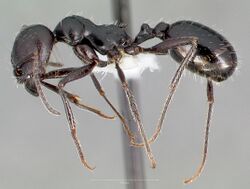Biology:Messor pergandei
| Messor pergandei | |
|---|---|

| |
| M. pergandei worker from the United States | |
| Scientific classification | |
| Domain: | Eukaryota |
| Kingdom: | Animalia |
| Phylum: | Arthropoda |
| Class: | Insecta |
| Order: | Hymenoptera |
| Family: | Formicidae |
| Subfamily: | Myrmicinae |
| Genus: | Messor |
| Species: | M. pergandei
|
| Binomial name | |
| Messor pergandei Mayr, 1886
| |
Messor pergandei is a species of harvester ant native to the Southwestern United States, especially the deserts of southeastern California . It has also been identified in the Baja California peninsula of Mexico.[1] It was first described by Gustav Mayr, who named it Aphaenogaster pergandei.[2] It has also been referred to as Veromessor pergandei[1] when classified in the genus Veromessor (a junior synonym of Messor).[3] It can also be referred to as a black harvester ant or desert harvester ant, although these common names have also been applied to other species.[4][5]
Description
M. pergandei has a head of equal length and width, with very large mandibles. It has short white or yellow hair and a large thorax. Males typically measure about 8.5 mm (0.33 in) and females about 10 mm (0.39 in).[1] However, individual size can vary based on factors such as availability of food and interspecific competition. The species is named after American myrmecologist Theodore Pergande.[6]
Ecology
Like other harvester ants, M. pergandei gathers fruits and seeds for food. The seeds of perennial shrubs such as Larrea tridentata and Ambrosia dumosa are included in its diet.[7]
References
- ↑ 1.0 1.1 1.2 Wheeler, William Morton; Creighton, William Steel (1934). "A study of the ant genera Novomessor and Veromessor". Proceedings of the American Academy of Arts and Sciences 69 (9): 341–387. doi:10.2307/20023057. http://antcat.org/documents/3647/3460.pdf. Retrieved 10 January 2013.
- ↑ Mayr, Gustav (1886). "Die Formiciden der Vereinigten Staaten von Nordamerika" (in German). Verhandlungen der Kaiserlich-Königlichen Zoologisch-Botanischen Gesellschaft (Vienna) 36: 419–464. http://antcat.org/documents/2158/4383.pdf. Retrieved 10 January 2013.
- ↑ "Veromessor". AntWiki. http://www.antwiki.org/Veromessor. Retrieved 10 January 2013.
- ↑ Lighton, J.R.; Bartholomew, G.A. (1988). "Standard energy metabolism of a desert harvester ant, Pogonomyrmex rugosus: Effects of temperature, body mass, group size, and humidity". Proceedings of the National Academy of Sciences of the United States of America 85 (13): 4765–4769. doi:10.1073/pnas.85.13.4765. PMID 16593953. Bibcode: 1988PNAS...85.4765L.
- ↑ "Black Harvester Ant". Orkin. Archived from the original on 30 August 2012. https://web.archive.org/web/20120830174202/http://www.orkin.com/ants/harvester-ant/black-harvester-ant/. Retrieved 10 January 2013.
- ↑ Davidson, Diane W. (1978). "Size variability in the worker caste of a social insect (Veromessor pergandei Mayr) as a function of the competitive environment". The American Naturalist 112 (985): 523–532. doi:10.1086/283294. http://content.lib.utah.edu/cdm/ref/collection/uspace/id/3328. Retrieved 10 January 2013.
- ↑ Wissinger, Benjamin D. (2012). Perennial shrub and harvester ant responses to environmental gradients in southern California deserts (Thesis). University of Idaho. OCLC 823874661.
External links
- Messor pergandei at AntWeb
- "Oldstyle id: 6879700". Species 2000: Naturalis, Leiden, the Netherlands. http://www.catalogueoflife.org/col/details/species/id/6879700.
Wikidata ☰ Q12061726 entry

